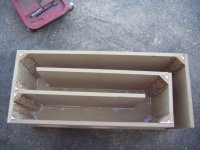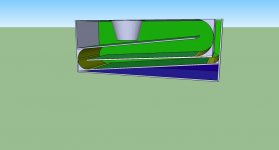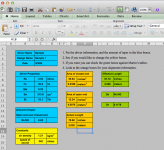Hello all,
I’m making my first transmission line attempt and am starting to get overwhelmed with theory, examples, and techniques and could use some advice (I’ve scoured many many forums for a few weeks now)…
This project is for a subwoofer to round out the sound in my car. However, when I perform internet seraches of similar designs, most of the car audio T-Lines are linear (cross-sectional area equal to the Sd throughout)… Nor are they stuffed/damped
Example (the glued/fabbed MDF picture below)
It’s my understanding (after reading all of MJK’s write-ups and pouring over his tables), that a linear/straight transmission line with no taper is not the most ideal of designs, that either an expanding or contracting taper have greater benefits- namely:
Contracting = shorter length of the line/ less issues with phase / impedance / high frequency interference.
Expanding = larger length of line, but greater output from the mouth (while increasing to a “compromised exponential horn” ratio).
Am I missing something? I’m attaching my mockup design from sketchup for a comparison.
The So = is ~ 60in (6x10)
The Sl = is ~ 1 3/16”
I’m unable to download a version of MathCad at the moment to test out MJK’s worksheets, but I’ve forged on the best I can with my trusty Ti-84 and MJK’s tables (also, I only have access to Macs).
** However, I did come across an Excel spreadsheet that I’m attaching a pic of, if anyone has any experience with this or thoughts?
I’d be forever grateful for any support and advice.
**Edit** I should add that I’d prefer for the speaker to be facing/firing up as it saves me space in my little Prius hatchback, however – will this positioning effect the movement of air due to the inclines / friction / gravity?
Thank you in advance.
~ Ross
Subwoofer chosen: Dayton DCS205-4 8”
Dayton Audio DCS205-4 8" Classic Subwoofer 4 Ohm
I’m making my first transmission line attempt and am starting to get overwhelmed with theory, examples, and techniques and could use some advice (I’ve scoured many many forums for a few weeks now)…
This project is for a subwoofer to round out the sound in my car. However, when I perform internet seraches of similar designs, most of the car audio T-Lines are linear (cross-sectional area equal to the Sd throughout)… Nor are they stuffed/damped
Example (the glued/fabbed MDF picture below)
It’s my understanding (after reading all of MJK’s write-ups and pouring over his tables), that a linear/straight transmission line with no taper is not the most ideal of designs, that either an expanding or contracting taper have greater benefits- namely:
Contracting = shorter length of the line/ less issues with phase / impedance / high frequency interference.
Expanding = larger length of line, but greater output from the mouth (while increasing to a “compromised exponential horn” ratio).
Am I missing something? I’m attaching my mockup design from sketchup for a comparison.
The So = is ~ 60in (6x10)
The Sl = is ~ 1 3/16”
I’m unable to download a version of MathCad at the moment to test out MJK’s worksheets, but I’ve forged on the best I can with my trusty Ti-84 and MJK’s tables (also, I only have access to Macs).
** However, I did come across an Excel spreadsheet that I’m attaching a pic of, if anyone has any experience with this or thoughts?
I’d be forever grateful for any support and advice.
**Edit** I should add that I’d prefer for the speaker to be facing/firing up as it saves me space in my little Prius hatchback, however – will this positioning effect the movement of air due to the inclines / friction / gravity?
Thank you in advance.
~ Ross
Subwoofer chosen: Dayton DCS205-4 8”
Dayton Audio DCS205-4 8" Classic Subwoofer 4 Ohm
Attachments
A few things:
1. A TL is not the most efficient use of space. Consider that the space that a TL for an 8" driver could be as much as that occupied by a simple 2x10 vented (or 2x12 sealed) design.
2. HornResp can be used to model TLs. And THs. And TQWPs. And sealed and vented enclosures. You get the drift. Download a copy, get used to how it works, and you'll be able to model almost any useful alignment you can come up with.
3. If you do choose to build a DL, don't bother with the corner roundovers in your build. They are basically useless in a TL designed for subwoofer duty and only take up space. Considerably more important for a good subwoofer build is getting the bracing right to minimize panel flex.
4. What led you to choose that specific driver for your build?
1. A TL is not the most efficient use of space. Consider that the space that a TL for an 8" driver could be as much as that occupied by a simple 2x10 vented (or 2x12 sealed) design.
2. HornResp can be used to model TLs. And THs. And TQWPs. And sealed and vented enclosures. You get the drift. Download a copy, get used to how it works, and you'll be able to model almost any useful alignment you can come up with.
3. If you do choose to build a DL, don't bother with the corner roundovers in your build. They are basically useless in a TL designed for subwoofer duty and only take up space. Considerably more important for a good subwoofer build is getting the bracing right to minimize panel flex.
4. What led you to choose that specific driver for your build?
1. I know it's a terribly inefficient use of space  but I really am wanting to build a T-Line (I'm tired of sealed and ported) - though maybe a single reflex bandpass as an alternative?
but I really am wanting to build a T-Line (I'm tired of sealed and ported) - though maybe a single reflex bandpass as an alternative?
2. As soon as I can get my hands on a windows OS i'll peck away at Hornresp. I hear great things (and eventually, on the horizon, I'd like to build a tapped horn).
3. Hm. Okay. Well, the roundovers will give me more surface area for bracing/fixing the sides together - as this mockup already exceeds the drivers enclosure volume suggestions (winisd)- but if you think they offer zero benefit I'll reconsider.
4. the Dayton = I already own it, and being a student I'm tight on $.
as of right now, the dimensions for the t-line I have mocked up there are H: 14" W: 25" D: 10" (I really should get more accustomed to the metric system)
2. As soon as I can get my hands on a windows OS i'll peck away at Hornresp. I hear great things (and eventually, on the horizon, I'd like to build a tapped horn).
3. Hm. Okay. Well, the roundovers will give me more surface area for bracing/fixing the sides together - as this mockup already exceeds the drivers enclosure volume suggestions (winisd)- but if you think they offer zero benefit I'll reconsider.
4. the Dayton = I already own it, and being a student I'm tight on $.
as of right now, the dimensions for the t-line I have mocked up there are H: 14" W: 25" D: 10" (I really should get more accustomed to the metric system)
- Status
- This old topic is closed. If you want to reopen this topic, contact a moderator using the "Report Post" button.


